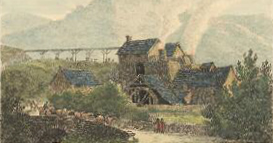
Discover Your Ancestors
Two critically acclaimed publications are available to family history researchers - the annual print magazine, Discover Your Ancestors, and the monthly online magazine, Discover Your Ancestors Periodical. Click here to subscribe.Carmarthenshire

Before the Romans arrived in Britain, the land now forming the county of Carmarthenshire was part of the kingdom of the Demetae, who gave their name to the county of Dyfed; it contained one of their chief settlements, Moridunum, now known as Carmarthen. The Romans established two forts in South Wales, one at Caerwent to control the south-east of the country, and one at Carmarthen to control the south-west. The fort at Carmarthen dates from around 75 AD, and there is a Roman amphitheatre nearby, so this probably makes Carmarthen the oldest continually occupied town in Wales.
Carmarthenshire has its early roots in the region formerly known as Ystrad Tywi (‘Vale of [the river] Tywi’) and part of the Kingdom of Deheubarth during the High Middle Ages. After the Normans had subjugated England they tried to subdue Wales. Carmarthenshire was disputed between the Normans and the Welsh lords and many of the castles built around this time, first of wood and then stone, changed hands several times. Following the Conquest of Wales by Edward I, the region was reorganized by the Statute of Rhuddlan in 1284 into Carmarthenshire. Edward I made Carmarthen the capital of this new county, establishing his courts of chancery and his exchequer there, and holding the Court of Great Sessions in Wales in the town.
The Normans transformed Carmarthen into an international trading port, the only staple port in Wales. Merchants imported food and French wines and exported wool, pelts, leather, lead and tin. In the late medieval period the county’s fortunes varied, as good and bad harvests occurred, increased taxes were levied by England, there were episodes of plague, and recruitment for wars removed the young men. Carmarthen was particularly susceptible to plague as it was brought in by flea-infested rats on board ships from southern France.
In 1405, Owain Glyndŵr captured Carmarthen Castle and several other strongholds in the neighbourhood. However, when his support dwindled, the principal men of the county returned their allegiance to King Henry V. During the English Civil War, Parliamentary forces besieged and captured Carmarthen Castle but later abandoned the cause, and joined the Royalists. In 1648, Carmarthen Castle was recaptured by the Parliamentarians.
The first industrial canal in Wales was built in 1768 to convey coal from the Gwendraeth Valley to the coast, and the following year, the earliest tramroad bridge was on the tramroad built alongside the canal. During the Napoleonic Wars (1799–1815) there was increased demand for coal, iron and agricultural goods, and the county prospered. The landscape changed as much woodland was cleared to make way for more food production, and mills, power stations, mines and factories sprang up between Llanelli and Pembrey. Carmarthenshire was at the centre of the Rebecca Riots around 1840, when local farmers and agricultural workers dressed as women and rebelled against higher taxes and tolls.
On 1 April 1974, under the Local Government Act 1972, Carmarthenshire joined Cardiganshire and Pembrokeshire in the new county of Dyfed; Carmarthenshire was divided into three districts: Carmarthen, Llanelli and Dinefwr. Twenty-two years later this amalgamation was reversed when, under the Local Government (Wales) Act 1994, the original county boundaries were reinstated.
Exclusive census analysis from data at TheGenealogist reveals that common surnames in Carmarthenshire in the 19th century included John, Phillips and Bowen; plus Morgans and Richards in 1841 and Harries in 1911. The population rose from 106,000 in 1841 to 152,000 in 1911, with the coal industry dominating occupations.
Carmarthen Records Online
Leading data website TheGenealogist.co.uk has a wealth of records for Carmarthenshire (part of the modern ‘preserved county’ of Dyfed). Here is a quick run-down of what you can find (in addition to national collections):
- Trade directories: three directories for South Wales, for 1835, 1844 and 1938.
- Census records: Carmarthenshire records for every census from 1841 to 1911.
- Parish registers: various books of historical records from West Wales, covering Carmarthenshire, from 1910 to 1929.
- Nonconformist registers: Nonconformist chapels and meeting houses across Carmarthenshire are covered in the site’s collections.
- Land owners: the site’s huge collection of tithe commutation records includes Carmarthenshire, along with tithe maps; plus an 1873 survey of Welsh and English landowners includes the region.
- Wills: many people from Hunts can be found in Prerogative Court of Canterbury (PCC) Wills 1384-1858.